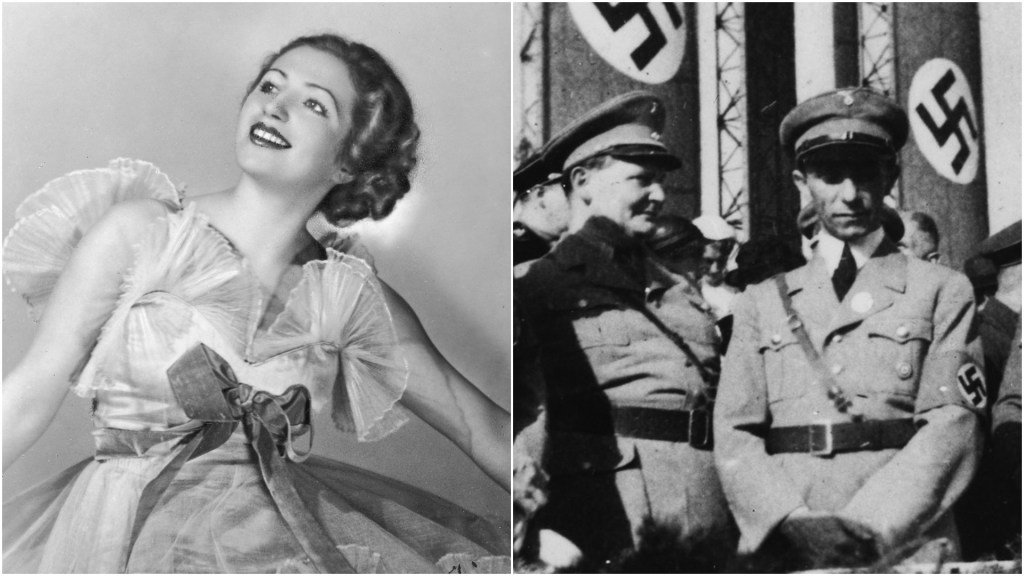What would you do in the face of certain death? Would you accept your fate or fight until your fleeting breath? For Franceska Mann, or Franciszka Mannówna, a Polish-Jewish dancer on her way to the Auschwitz gas chamber, the answer was a no-brainer.
Franceska Mann was a beautiful and exceptionally talented dancer, pirouetting her way through many prestigious shows and competitions, including the Brussels International Dance Competition of May 1939 where she won fourth prize. She danced regularly in Warsaw’s Melody Palace nightclub before the outbreak of the Second World War and her career-shattering imprisonment in the Warsaw Ghetto. In 1943 she was transported out of Poland, presumably in connection with the Hotel Polski Affair, where Jews hoping to escape to South America with foreign passports were tricked and sent to Auschwitz instead.
Videos by VICE
According to some accounts, these ‘exchange Jews’ were told that they had in fact arrived at Bergau to be disinfected before crossing the border to Switzerland and led to the undressing room next to the gas chamber. There are many variations of the Franceska Mann story but perhaps the most sensational is told by Holocaust historian Cynthia Southern. While undressing, Mann purportedly tantalized two leering guards with a striptease, lifting her skirt to expose her thigh to Josef Schillinger and Wilhelm Emmerich and seductively moving aside her blouse.
She then swiftly removed her shoe to strike Schillinger in the forehead, before pulling the gun from his pocket and firing two fatal shots into his stomach and one into Emmerich’s leg. The other women in the undressing room joined the revolt, although none of them were able to escape.
Watch now: Broadly Voices: Gloria Steinem & Nadia Murad
When the wide-eyed @xnulz asked Twitter to “Name a bitch badder than Taylor Swift” in November of 2017, it was no surprise that this version of the Franceska Mann chronicle, tweeted by @moviehistories, was among the most popular (over 35,000 RTs and counting) in a barrage of responses celebrating infinitely more impressive historical heroines. But how much of this account can be corroborated with cold, hard evidence? To get a clearer picture, I spoke to one of the world’s leading Auschwitz experts: author, professor and historian Dr. Robert Jan van Pelt.
“It is indeed very difficult to establish the truth about what happened in the undressing room at some date in October 1943. The chain of evidence is thin,” he tells me. “We know that a revolt took place by an arriving transport because a German document exists from December 1943 in which two SS men who helped put the revolt down, Rudolf Grimm and Fritz Lackner, were put forward to receive a medal. The document does not describe the nature of the revolt, or any details.”
According to Dr. van Pelt there are three key reports to consider: Auschwitz escapee “Jerzy Wesoloski (alias “Tabeau”) describes [the incident] in his report made after his escape. This report was published as part of the Auschwitz Protocols in late 1944 by the War Refugee Board. The key points of his report are that women defended themselves, and that a certain SS man named ‘Schiller’ died. The woman who snatched the revolver is not identified.
“Rudolf Höss mentions the incident first in his statement of March 14, 1946—immediately after his capture by the British. He implies that those who revolted were women, but gives no details. In April 1945 Stanislaw Jankowski told in a deposition made in Poland which mentioned a woman snatching a revolver from [Walter] Quackernack [a Nazi guard in charge of the crematorium] and shooting Schillinger.”

Although we cannot conclusively identify the woman in question as Franceska Mann, knowing that she may have been a dancer makes it seem much more plausible. “The idea that the woman might have been a dancer, as far as I know, is first mentioned in 1946 by [Holocaust survivor and historian] Eugen Kogon, who was not in Auschwitz but in Buchenwald,” Dr. van Pelt adds.
While it’s hard to iron out the facts, we do know that an incredible act of resistance did take place that day from a woman who had the guts to fight back. As Auschwitz survivor Wieslaw Kielar states in his memoir, Anus Mundi: Five Years in Auschwitz: “The incident passed from mouth and embellished in various ways grew into a legend. Without doubt, this heroic deed by a weak woman in the face of certain death, gave moral support to every prisoner. We realized all at once that if we dared raise a hand against them, that hand might kill; they were mortal, too.”
For More Stories Like This, Sign Up for Our Newsletter
Like all great legends, Mann’s story lived on in fiction. Arnošt Lustig’s 1964 novel A Prayer for Katerina Horovitzova—adapted into a movie in 1965—centers around a young dancer held to ransom by the German authorities in wartime Italy. Realizing she would die after all, she shoots her captors at the gas chamber door. Auschwitz survivor Tadeusz Borowski’s novel This Way for the Gas, Ladies and Gentlemen includes the short story The Death of Schillinger, in which the guard is similarly outsmarted by an attractive woman and shot in the stomach with his own gun.
Fact or fiction, it doesn’t get badder than this.
More
From VICE
-

Screenshot: Ubisoft -

Collage by VICE -

Screenshot: MOJANG -

(Photo by VALERIE MACON/AFP via Getty Images)
